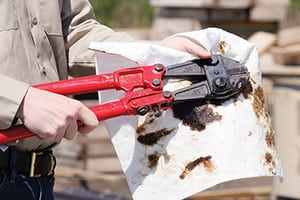 Do you frequently use washcloths or rags to wipe up oil, lubricants or other solvents in your workplace? If so, you’ll want to familiarize yourself with the Environmental Protection Agency’s (EPA) rule regarding solvent-contaminated wipes. It outlines the best practices for dealing with solvent-contaminated wipes, without negatively impacting human health or the environment.
Do you frequently use washcloths or rags to wipe up oil, lubricants or other solvents in your workplace? If so, you’ll want to familiarize yourself with the Environmental Protection Agency’s (EPA) rule regarding solvent-contaminated wipes. It outlines the best practices for dealing with solvent-contaminated wipes, without negatively impacting human health or the environment.
Whether your workplace uses a single rag or dozens on a regular basis, it’s a good idea to follow the standards set forth in the EPA’s new rule.
What is a solvent-contaminated wipe?
Wipes containing one or more of the following chemicals are considered to be “solvent-contaminated”
- Acetone
- Isobutyl alcohol
- Benzene
- Methanol
- n-Butanol
- Methyl ethyl ketone
- Chlorobenzene
- Methyl isobutyl ketone
- Creosols
- Methylene chloride
- Cyclohexanone
- Tetrachloroethylene
- 1,2-Dichlorobenzene
- Toluene
- Ethyl acetate
- 1,1,2- Trichloroethane
- Ethyl benzene
- Trichloroethylene (*For reusable wipes only.)
- 2-Ethoxyethanol
- Xylenes
What’s The Purpose of The New Rule?
The purpose of the new EPA solvent-contaminated wipe rule is simple: to reduce the chance of environmental and/or human health problems related to rags, towels, wipes, mats, pads, and washcloths soaked with solvent chemicals. Since this rule was created by the EPA, it affects all companies in the U.S. With that said, some states may have their own rules and regulations regarding solvent-contaminated wipes.
Of course, a side benefit that comes from the new EPA solvent contaminated wipes rule is the cost savings it has on companies and employers. The EPA estimates that LQG facilities will save over $30,000 and SQG facilities will save over $,4000 per year thanks to the new rule.
Proper Storage of Solvent-Contaminated Wipes
One of the key points of the new rule involves proper storage of solvent-contaminated wipes. If a company uses a wipe containing one or more of the previously mentioned chemicals, they must designate a closed container specifically for storing them. The container must be liquid proof, have a tight-fitting lid, and labeled: “Excluded solvent-contaminated wipes.”
“Wipes must be accumulated, stored, and transported in non-leaking, closed containers,” said the EPA.
Move ‘Em Out!
Under this new EPA rule, all solvent-contaminated wipes must be disposed within 180 days. Companies are free to store solvent-contaminated wipes on site for up to 180 days, at which point they must be properly disposed by a professional waste removal business.
Note: the new EPA rule went into effect on January 31st, 2014.
Feel free to visit the EPA’s official website for more information including FAQs about the new solvent-contaminated wipes rule. While most of the rule focuses on storage and handling, there are some other elements that are worth noting.